Throughout history, firearms have not only been tools of defense and offense but also objects of art, innovation, and sometimes, sheer oddity. They showcase exquisite craftsmanship with intricate engravings, precious metal inlays, and detailed woodwork. These pieces were often more than just functional weapons; they were symbols of status and works of art, commissioned by the elite of the time. Their aesthetic appeal lies not just in their appearance but also in the exceptional skill and meticulous work that went into creating them. Today we’ll delves into some of the most classy and bizarre guns from the past, each with its unique story and characteristics that set it apart in the annals of firearms history.
Innovation and Oddity
On the other end of the spectrum, some historical firearms stand out for their bizarre and unconventional designs. These guns reflect the inventive – sometimes even eccentric – spirits of their creators. From unusual firing mechanisms to strange forms and purposes, these firearms pushed the boundaries of what a gun could be. They serve as testaments to the experimental nature of weapon development throughout history.
Tactical Evolution
The evolution of firearms has been a continuous journey of technological advancements, and these guns played their part in it. Some were groundbreaking for their time, introducing new technologies or tactics in warfare and hunting. They often paved the way for future developments, influencing the design and function of modern firearms.
Cultural and Historical Significance
Beyond their physical characteristics, these guns often hold significant cultural and historical value. They might have been used in notable historical events or belonged to famous figures. Their stories contribute to our understanding of different periods in history, shedding light on the technological, political, and social contexts of the times they were used in.
#1 Gyrojet guns (1960s)
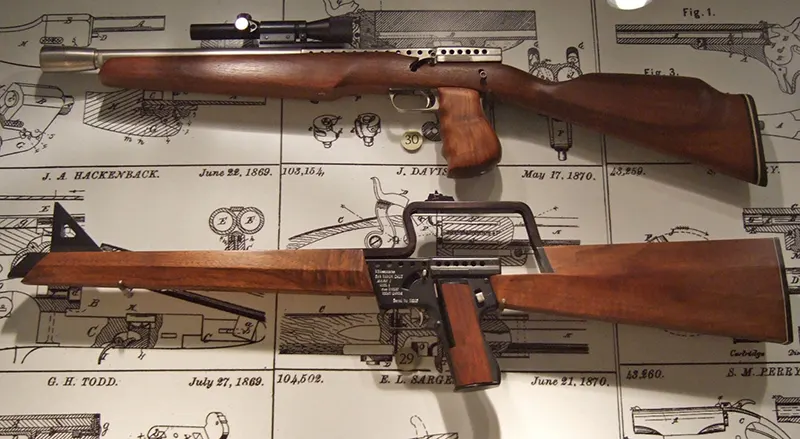
traditional guns that fire inert bullets, the Gyrojet family of firearms shoots small rocket-propelled projectiles known as Microjets. These rockets, unlike standard bullets, generate minimal recoil, allowing for a lighter and less robust construction of the firearm, as there is no need for a heavy barrel or chamber to contain combustion gases.
A unique characteristic of the Gyrojet's Microjets is their velocity profile. Upon leaving the barrel, the velocity is relatively low, but it significantly increases as the projectile travels, reaching around 1,250 feet per second at a distance of 30 feet. This increasing velocity over distance contrasts with traditional bullets, which typically lose speed after leaving the barrel.
The Gyrojet's innovative design resulted in a weapon that was remarkably lightweight and easy to transport, making it a novel addition to the firearms market at the time. However, it eventually fell out of production and today, Gyrojet firearms are highly sought-after collector's items. Prices for even the most common models can exceed $1,000. Moreover, firing a Gyrojet is a rare occurrence due to the scarcity and high cost of ammunition, with individual rounds sometimes costing over $100.
#2 Whitney Wolverine: The Atomic Age Pistol (1956)
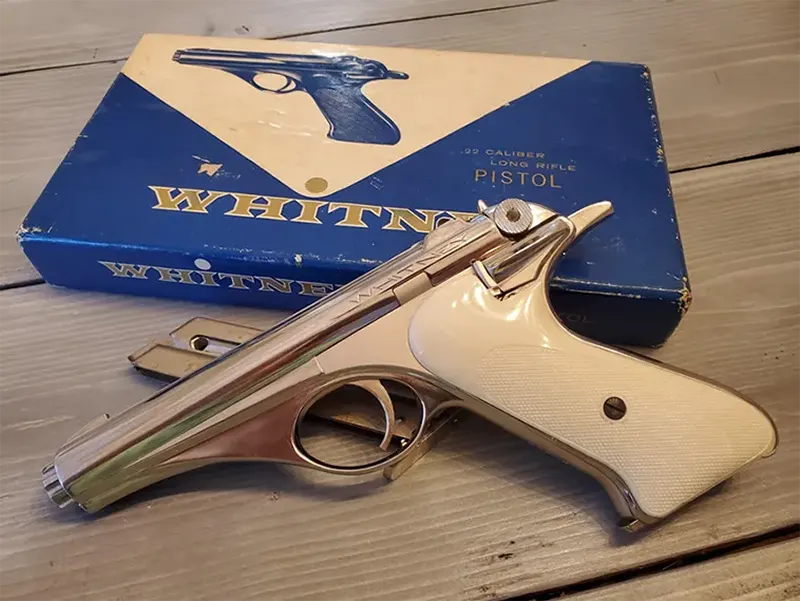
The Whitney Wolverine, a semi-automatic .22 LR caliber pistol, emerged in 1956 as a notable example of mid-century firearm innovation. Designed by Robert Hillberg, a WWII veteran with expertise in aircraft guns, this pistol stood out for its "space-aged" aesthetic and pioneering use of aluminum, a lightweight material then uncommon in firearms. The Wolverine featured a 4.625-inch barrel and a 10-round magazine, with an overall weight of just 23 ounces. Only 13,371 units were produced between 1956 and 1958, making it a rare collector's item.
Hillberg named the pistol "Wolverine" as a nod to his favorite football team, the University of Michigan Wolverines. The Whitney name was chosen due to the factory's proximity to the site of Eli Whitney's historical factory. The pistol's grips were available in black, dark brown, or white, with the white grips typically adorning the nickel-plated models.
Despite its advanced design and unique features, the Wolverine suffered from poor marketing and financial troubles. It was also underpriced by just $2 by competitors Ruger and Colt, who released new .22 semi-automatics around the same time. These challenges led to the pistol's short production run. Originally priced at $39.95 for the blue model and $44.95 for the nickel-plated variant, these prices now equate to approximately $398 and $448, highlighting its value as a piece of firearm history.
#3 German hunting knife that’s also a gun and a calendar (1528)
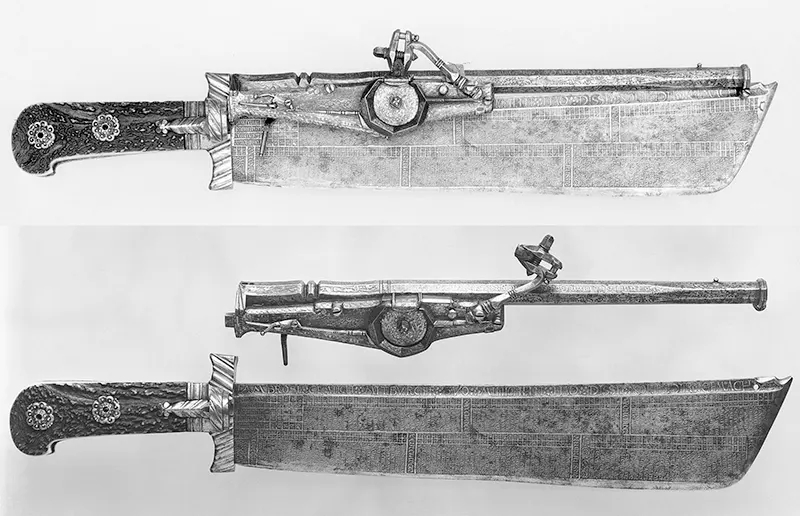
The German hunting knife from 1528 is a remarkable example of multi-functional design and craftsmanship from the early Renaissance period. This extraordinary artifact combined the utility of a knife with the lethal capability of a firearm and the practicality of a calendar, a testament to the ingenuity and skill of its creators.
Crafted in a time when firearms were becoming more prevalent, this knife-gun-calendar hybrid reflects the era's fascination with mechanical innovation and versatility. The blade, likely used for hunting and general utility, represents the traditional aspect of the tool. Meanwhile, the inclusion of a functional firearm within the knife's structure is a remarkable feat, showcasing the advanced metallurgy and engineering of the period. This combination of blade and firearm would have made it a valuable tool for hunters, offering both close-range utility and the ability to hunt from a distance.
Furthermore, the integration of a calendar into this device is a unique feature, underscoring the importance of timekeeping and scheduling in the daily life of its user. This could have been used for tracking dates for hunting seasons, agricultural activities, or religious observances, making it a multifaceted tool for both survival and social organization.
#4 Napoleon’s three-chamber box lock pistol (1802)
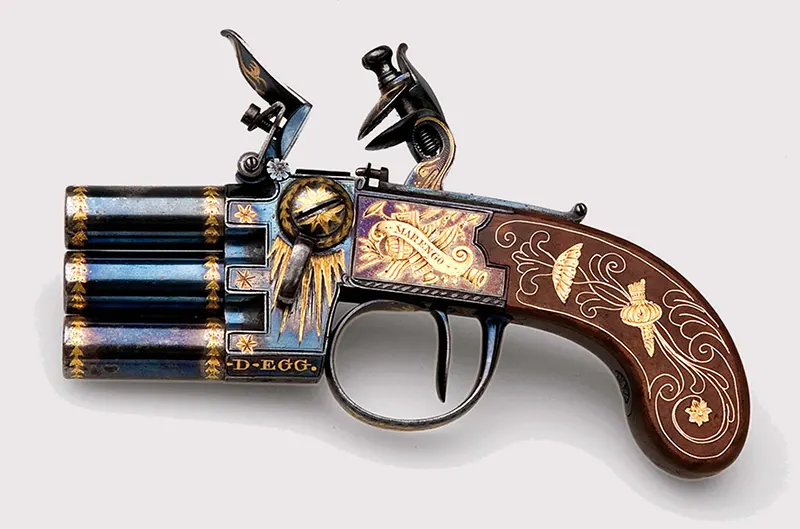
Napoleon Bonaparte's three-chamber box lock pistol, crafted in 1802, is an emblematic piece of early 19th-century weaponry, reflecting the technological advancements and personal tastes of one of history's most influential figures. This pistol, attributed to the personal armory of Napoleon, showcases the sophistication and ingenuity of firearms design during the Napoleonic era.
The three-chamber box lock mechanism is a notable feature of this pistol. Unlike the typical single-shot pistols of the time, this three-chamber design allowed for multiple firings before needing to reload, a significant advantage in both military and personal defense scenarios. This design was an early attempt to increase the rate of fire, a concept that would evolve dramatically in the years to follow.
The box lock mechanism, where the firing mechanism is enclosed within a box-like housing, was a departure from the traditional flintlock design. This made the pistol more compact and reliable, as the vital components were better protected from the elements. Such a design choice would have been appealing to someone like Napoleon, who valued both efficiency and reliability in his personal armaments.
#5 A knuckleduster/revolver (1870)
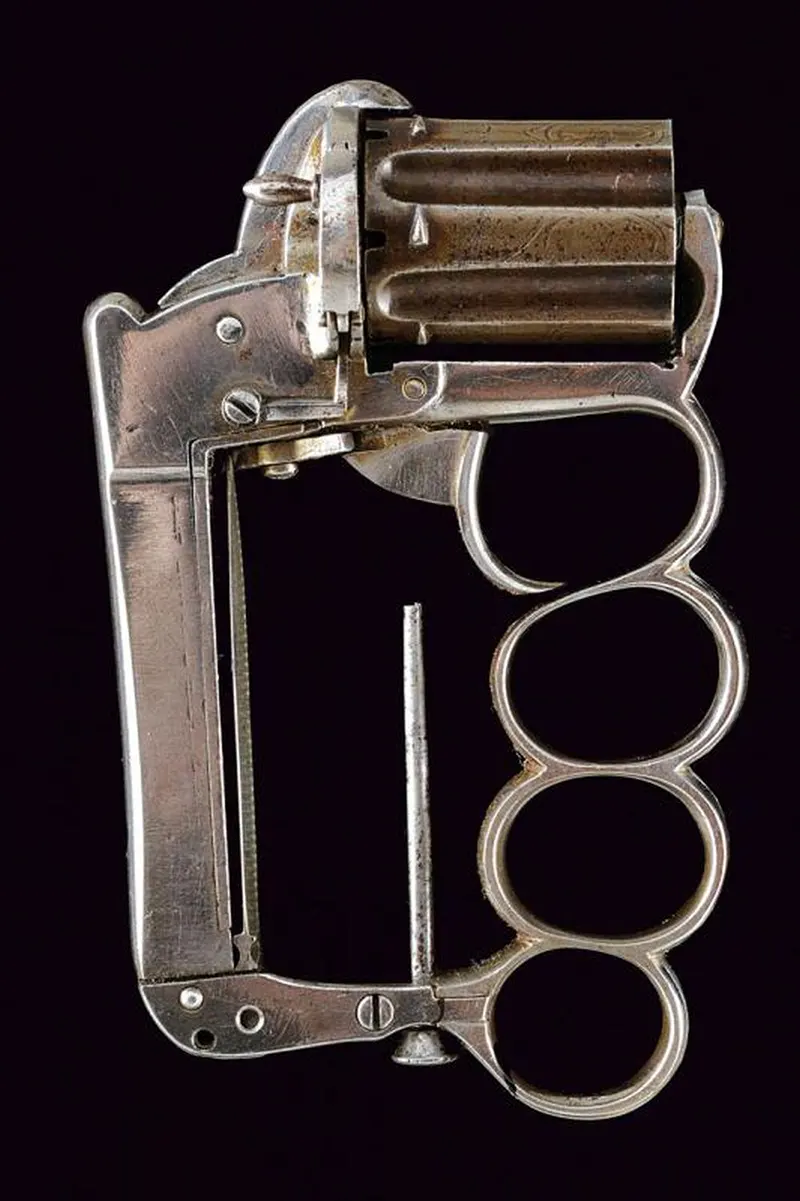
The Apache revolver, a unique and unconventional firearm from the late 19th century, epitomizes the era's experimental approach to personal defense weapons. This remarkable device integrates the functions of a pepperbox revolver, a knuckle duster, and a dual-edged knife, making it a versatile, albeit specialized, tool for close-quarters combat.
The Apache operates on the principle of a pepperbox revolver, utilizing pinfire cartridges. Unlike traditional revolvers with a single barrel, the pepperbox design features multiple barrels (in this case, the chambers themselves act as barrels), each with its own bullet. This design, while innovative, limits the weapon's effective range due to the absence of a dedicated barrel to guide the bullet.
The most distinctive feature of the Apache is its multi-functionality. The revolver's grip doubles as a fold-over knuckle duster, providing a powerful melee weapon. Additionally, a rudimentary foldout knife extends from the weapon, offering another layer of close-range defense or utility.Due to its compact design, the Apache is easily concealable. Its components, including the revolver section, the knuckle duster, and the knife, can be folded inward towards the cylinder, allowing for discreet carriage in a pocket. This made the Apache a favored weapon for undercover or covert operations, particularly in the criminal underworld.
#6 Makarov pistol, a birthday gift to Josef Stalin (1949)
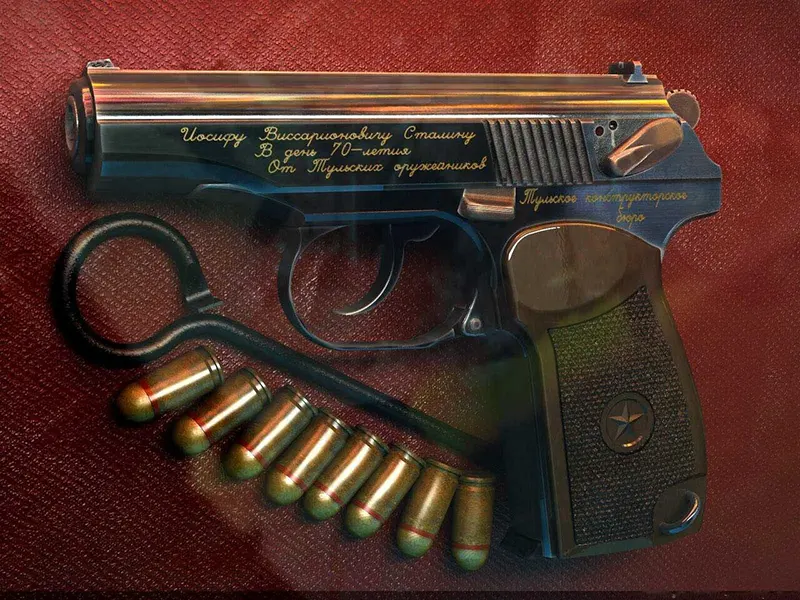
In 1949, Joseph Stalin received a unique birthday gift: a Makarov 9x18mm semi-automatic pistol, designed by Nikolay Fyodorovich Makarov. This pistol was chosen by the Soviet government for development and mass production, becoming the standard military and police sidearm by 1951. Crafted by gunsmiths in Tula, a city renowned for its arms manufacturing, the pistol bore a special engraving on its barrel: “To Joseph Vissarionovich Stalin, for 70th Birthday, from Tula Gunmakers.” This personalized weapon symbolized both Stalin's formidable power and the Soviet Union's advancement in arms technology during that era.
#7 Continental Four-barrel Flintlock Pistol (18th century)
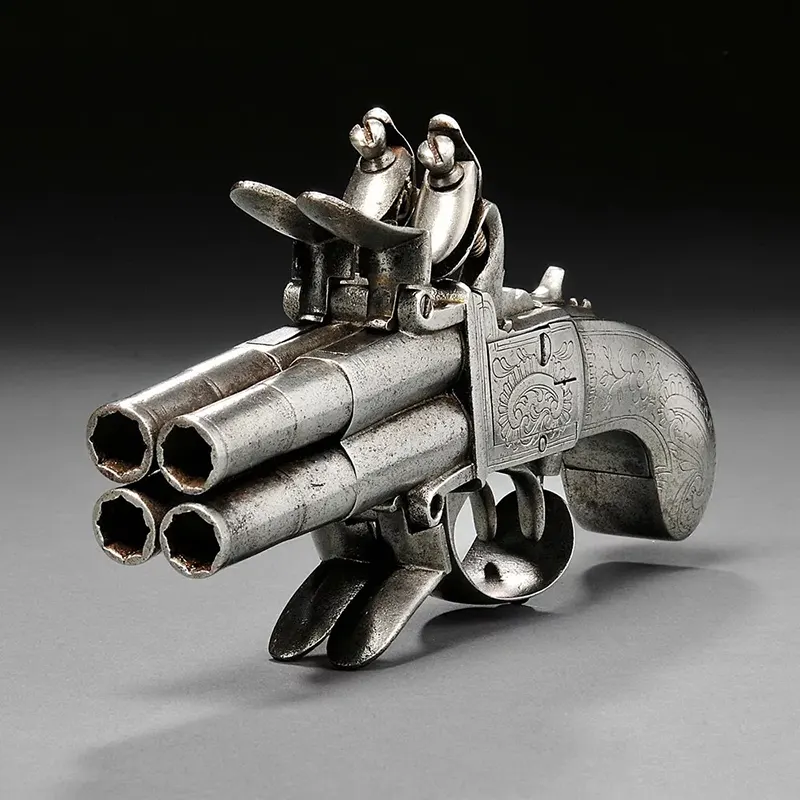
The Continental Four-barrel Flintlock Pistol, dating back to the late 18th century, is a remarkable example of early firearm engineering and decorative art. This pistol features an iron butt and frame intricately engraved with foliate designs, demonstrating the era's appreciation for both functionality and aesthetic detail. Its four rifled barrels, a significant innovation, suggest a focus on improved accuracy, a key advancement in firearm technology at the time. The pistol is equipped with two hammers and four steels, a complex mechanism allowing for multiple shots. With an overall length of 7 inches, this compact weapon was designed for convenience and ease of carry, likely serving as a personal sidearm. This piece not only reflects the craftsmanship of the period but also the evolving nature of firearms in the late 18th century.
#8 Double-Barreled Wheellock Pistol Made for Emperor Charles (1540)
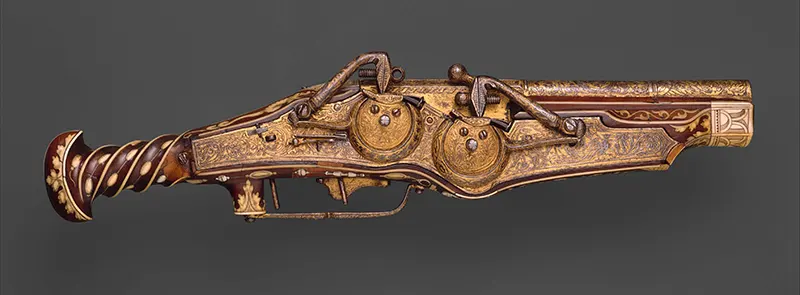
Peter Peck, a renowned maker of watches and guns, crafted one of the earliest pistols, specifically designed for Emperor Charles V, who reigned from 1519 to 1556. This firearm stands out for its advanced engineering, particularly for its time, featuring two locks combined into a single mechanism. This design allowed each of the barrels to have separate ignition, a significant innovation in early firearm technology.
The pistol is also notable for its artistic embellishments, which reflect the stature of its intended owner, Emperor Charles V. It is decorated with symbols representing his dynastic and personal emblems. The double-headed eagle, a symbol of the Holy Roman Empire, and the pillars of Hercules, emblematic of strength and determination, are prominently featured. Accompanying these is the Latin motto "PLUS ULTRA" (More beyond), signifying the Emperor's ambition and the spirit of exploration and expansion that characterized his reign.
#9 Wheellock pistol made for Maximilian I of Bavaria (1600)
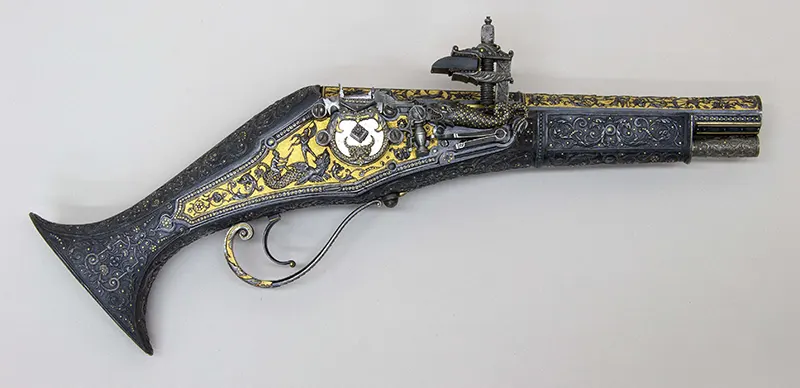
The German wheellock pistol, chiseled by Emanuel Sadeler around 1600–1610, is an exquisite example of early 17th-century craftsmanship and artistic expression in firearms. Its all-steel stock, a rarity for the time, likely served a dual purpose. Primarily, it provided a durable and robust framework for the weapon. More importantly, however, it offered Sadeler an expansive canvas to exhibit his intricate steel-chiseling skills.
The pistol is adorned with the coat of arms of Bavaria, prominently displayed on the pommel under a ducal crown. This decoration signifies the pistol's connection to nobility and power. Further enhancing its regal and prestigious appearance, the pommel is encircled by the collar of the Order of the Golden Fleece. This detail links the pistol to Duke Maximilian I, who became a knight of this esteemed order in 1600. The Order of the Golden Fleece was one of the most prestigious chivalric orders in Europe, and its inclusion on the pistol underscores its significance as a symbol of status and nobility.
#10 A multiple-barrel firearm (1800s)
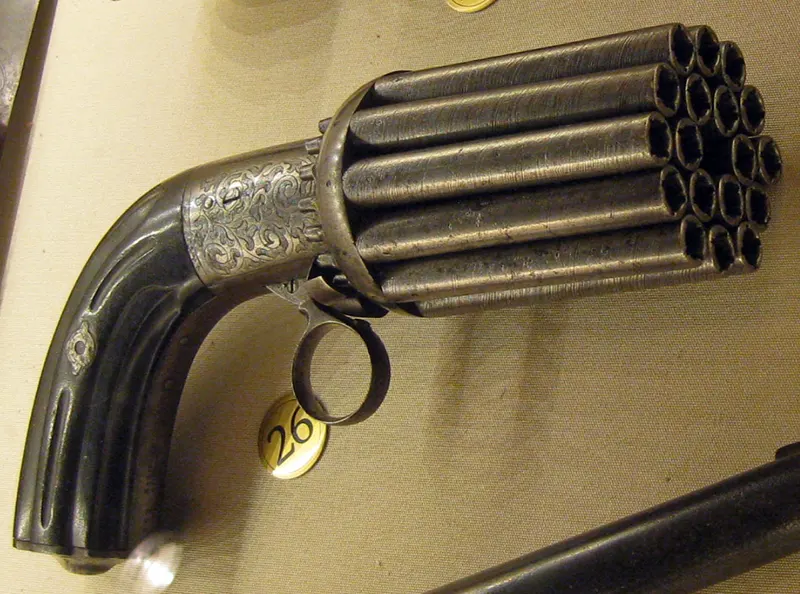
The pepperbox revolver, popular in North America from 1830 until the American Civil War, evolved from earlier multi-barreled firearms. Its roots trace back to the 15th century Ribauldequin, a version of the Volley gun, which featured several single-shot barrels attached to a stock, each fired individually by a match. By 1790, the pepperbox design had developed, incorporating flintlock mechanisms, as seen in creations by Nock in England and “Segallas” in Belgium.
These early pepperboxes, building on the success of two-barrel turnover pistols, were equipped with three, four, or even seven barrels. Initially, these barrels were hand-rotated, a feature that distinguished them from later revolving mechanisms. The pivotal invention of the percussion cap, following Rev. Alexander Forsyth’s 1807 patent for percussion powder, coupled with advancements brought by the Industrial Revolution, significantly impacted the development and production of pepperbox revolvers.
#11 Ottoman ivory-inlaid miquelet rifle
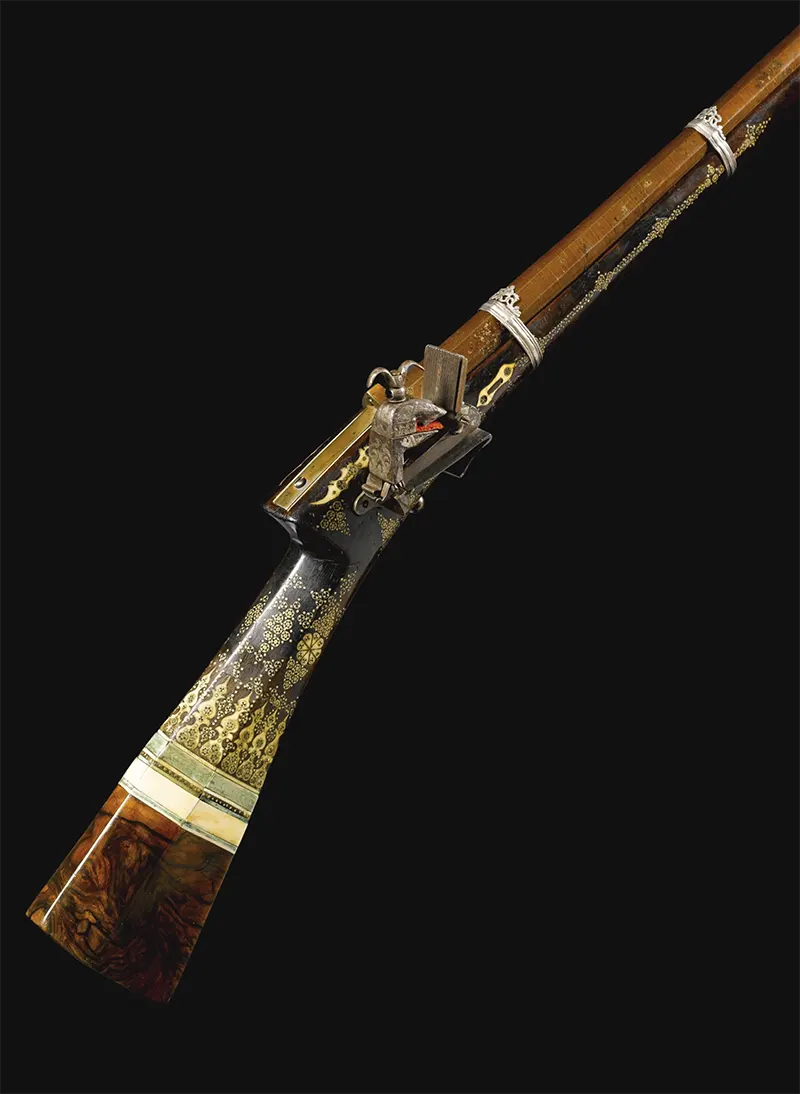
This described firearm, with its octagonal barrel crafted from watered-steel, exhibits a distinguished appearance and a level of craftsmanship indicative of its historical significance. The staining on the watered-steel barrel not only adds to its aesthetic appeal but also highlights the intricate metallurgical practices of the period. Watered-steel, known for its strength and distinctive patterned appearance, was a preferred material for high-quality firearms.
The barrel features a raised sighting plate, enhancing accuracy, which is secured to the horn-tipped forestock by three elegantly pierced silver capuchines. This combination of materials - horn, silver, and watered-steel - showcases a harmonious blend of utility and artistry.
The lock of the gun is adorned with inlaid-silver floral designs, further emphasizing the meticulous attention to detail and the artistic skill of the gunsmith. Such decorations were not just for show; they often denoted the gun's prestige and the status of its owner.
#12 Elgin cutlass pistol (1837)
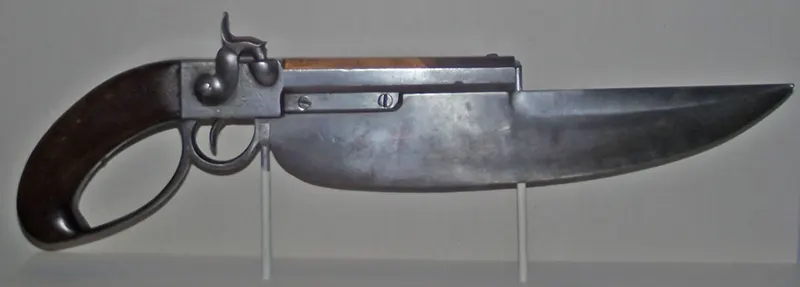
The pistol sword is a unique hybrid weapon combining a sword and a firearm, typically a pistol or revolver, designed primarily for use as a melee weapon with the firearm as a secondary feature. Unlike a rifle with a bayonet, where the gun is the main weapon and the blade is an addition, the pistol sword emphasizes the sword element, with the firearm complementing the blade's capabilities.
In these weapons, the sword and the firearm components are usually inseparably integrated, unlike the detachable bayonets often found on rifles. This integration showcases the weapon's purpose as a dual-function tool, providing the wielder with both close combat and ranged attack options. Historically, some flintlock pistols of the 17th and 18th centuries were made in this gun-sword style. The design typically involved attaching the barrel of the pistol alongside the blade of a shortsword or dagger.
#13 The Krummlauf Assault Rifle (1940s)
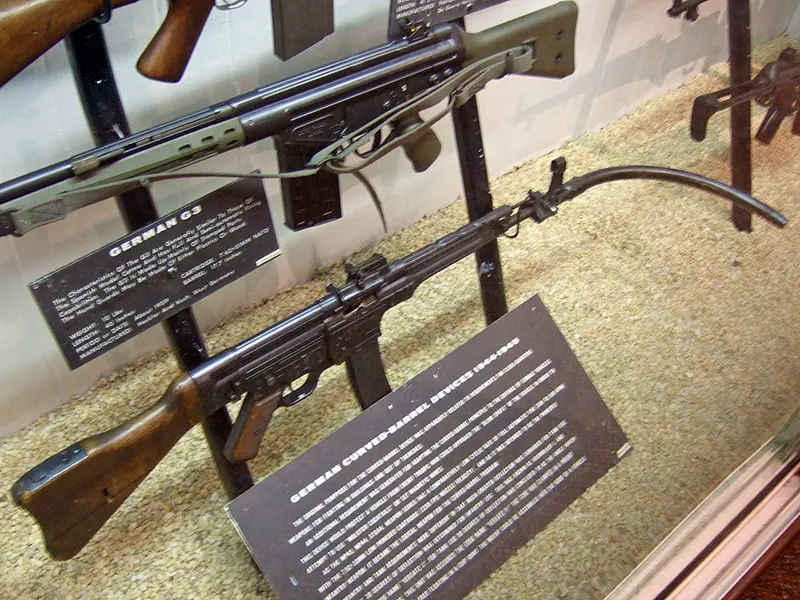
The Krummlauf, translating to "curved barrel," was an innovative yet unconventional attachment for the Sturmgewehr 44 assault rifle, primarily designed for use by tank crews during World War II. This device featured a barrel with a 30-degree bend and a periscopic sight, allowing soldiers to fire around corners without exposing themselves to enemy fire.However, the Krummlauf had significant limitations. The bent barrel placed immense stress on both the barrel and the bullets, leading to a drastically reduced lifespan of the attachment. The 30° variant could only withstand about 300 rounds, while the more sharply bent 45° version lasted for just 160 rounds. Additionally, the bending of the barrel often caused bullets to shatter upon firing, resulting in an unintended shotgun effect, where the bullets fragmented and spread upon exiting the barrel.
#14 The Velo Dog Revolver (19th century)
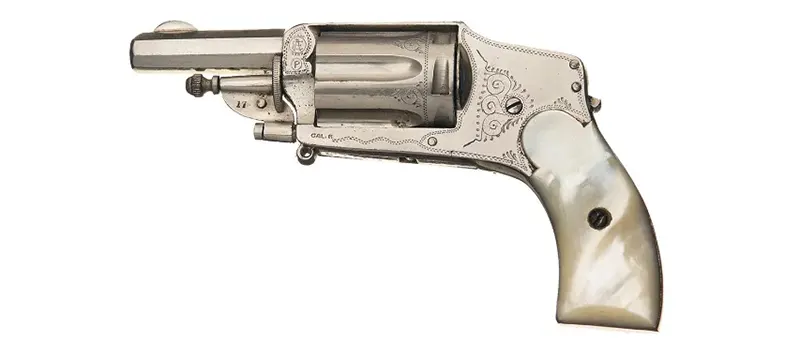
The emergence of the bicycle, or velocipede, as a popular mode of transportation in late 19th century France brought with it an unexpected challenge: enthusiastic dogs that found it entertaining to chase and nip at the heels of cyclists. To counter this, the Velo Dog revolver was invented by Rene Galand, offering a unique solution to the cyclists of that era.
This small, double-action pocket revolver was designed to be easily carried by cyclists. Its shrouded hammer prevented the weapon from snagging on clothing, an essential feature for quick access in motion. Later models of the Velo Dog revolver featured a long, guardless trigger, further streamlining its use.
The practice of using these revolvers to deter pursuing dogs, colloquially known as "dog plinking," gained such popularity that various configurations of the Velo Dog revolver were produced. This phenomenon reflects a period in history where personal defense and the evolving landscape of urban mobility intersected, leading to innovative, albeit peculiar, solutions like the Velo Dog revolver.
#15 The Duck Foot Pistol (18th century)
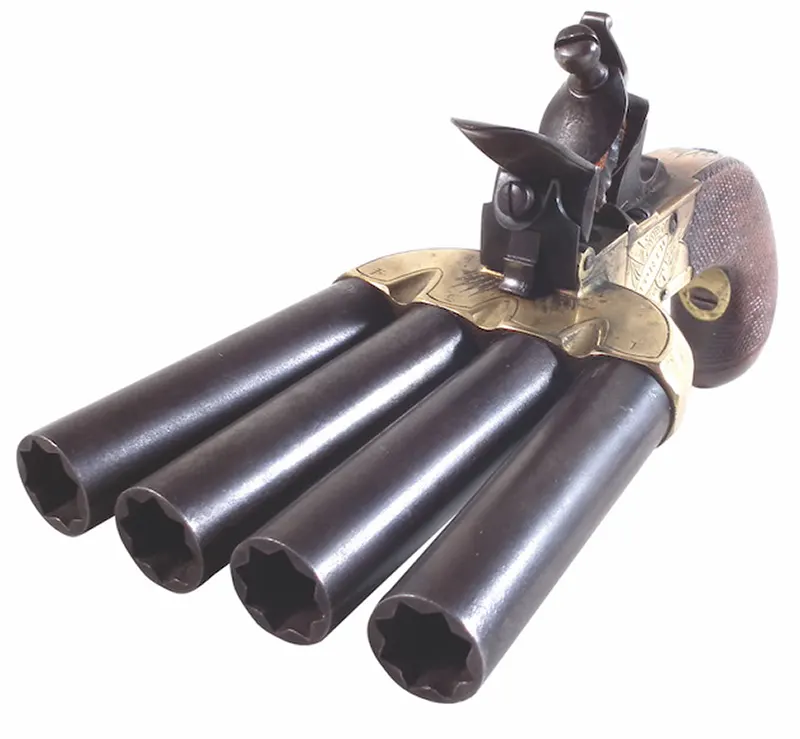
The firearm in question, commonly known as a "Duck's Foot" pistol due to its unique barrel configuration, represents an intriguing and unconventional design in historical weaponry. The distinguishing feature of this pistol is the arrangement of its multiple barrels, which fan out in a spread resembling a duck's webbed foot, typically at an angle of about 60 degrees.
This unusual design was not merely for aesthetic purposes; it had a practical application in close-range combat situations. The splayed barrels allowed the bullets to disperse over a wide area upon firing, increasing the likelihood of hitting multiple targets simultaneously. This characteristic made the Duck's Foot pistol particularly effective as an anti-personnel weapon in scenarios involving groups of adversaries, especially in confined spaces where the spread of the bullets could cover a significant portion of the area.
#16 Borchardt C-93 Pistol (1893)
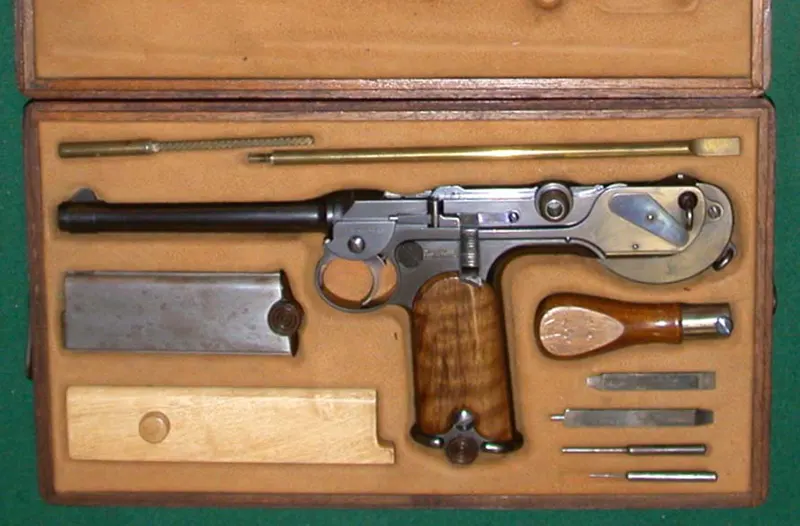
The Borchardt C93, designed by Hugo Borchardt in 1893, marks a significant milestone in firearm history as one of the first mass-produced semi-automatic pistols. Its design was influenced by the toggle lock mechanism of the Maxim gun, a groundbreaking approach at the time.
Borchardt also developed a specific cartridge for the C93, the high-velocity, bottlenecked 7.65×25mm Borchardt cartridge. Georg Luger, Borchardt's assistant, claimed to have had an influence on the design, a claim that would foreshadow his later contributions to firearm design.
The C93 was produced by Ludwig Loewe & Company of Berlin, Germany, and later by Deutsche Waffen- und Munitionsfabriken (DWM), with about 1,100 units made by Loewe and nearly 2,000 more by DWM. Despite its groundbreaking design, the Borchardt C93 had its drawbacks. It was expensive to produce and proved unwieldy due to its almost vertical grip and uneven weight distribution.
#17 Kolibri 2 mm Pistol (1910)
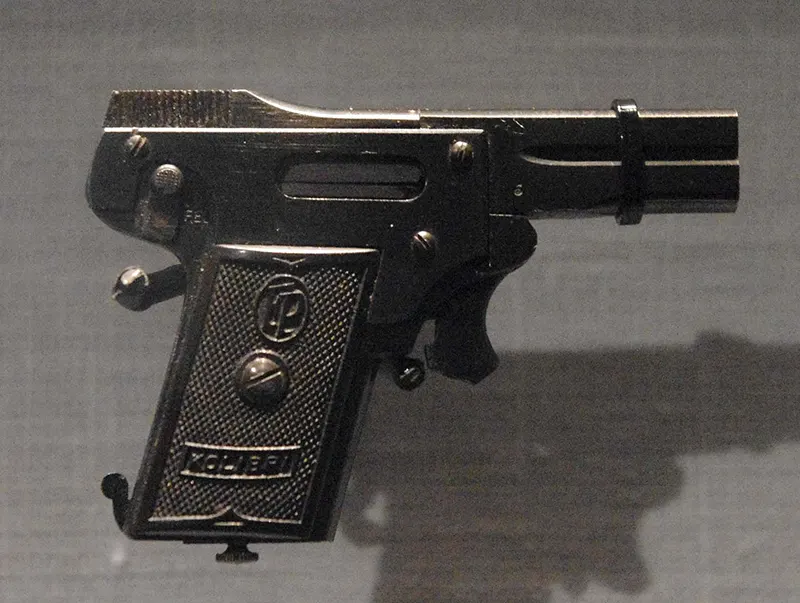
The 2mm Kolibri, patented in 1910 and introduced in 1914 by Austrian watchmaker Franz Pfannl with support from Georg Grabner, holds the distinction of being the smallest commercially available centerfire cartridge. This tiny cartridge was designed for use with the Kolibri semi-automatic pistol or a single-shot pistol, both of which were marketed as self-defense weapons. The name "Kolibri," German for "hummingbird," aptly reflects the diminutive size of these firearms and cartridges, akin to one of the smallest bird species.
Marketed primarily towards women, the 2mm Kolibri was touted as a convenient self-defense tool that could easily be carried in a handbag. However, the firearm's practicality was questionable due to its inherent weaknesses: it was both weak in power and inaccurate. While the Kolibri might not have been effective in stopping an aggressor if shot at the chest or limbs, it was believed that it could potentially cause damage if aimed at the face, a scenario that might deter an attacker.
#18 Harmonica Gun (18th century)
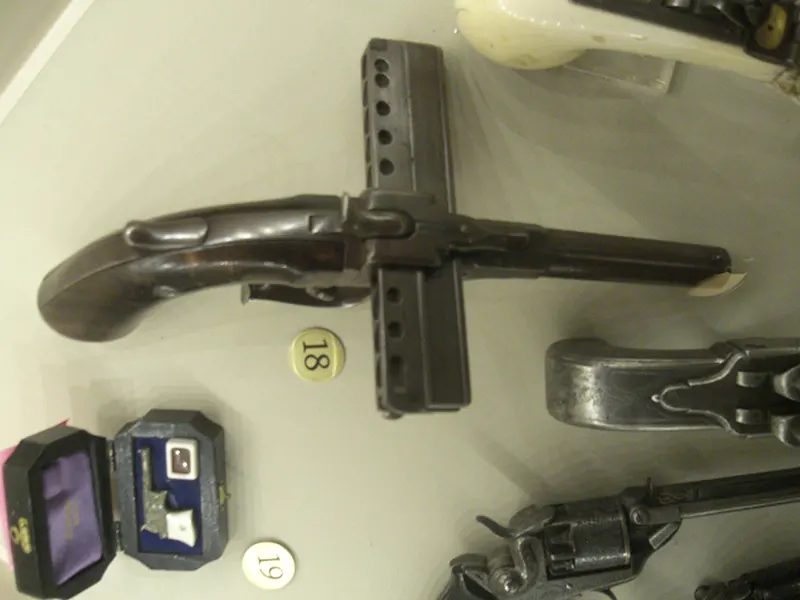
A harmonica gun, also known as a slide gun, is a unique type of firearm that features a steel slide as its breech-loading mechanism. This slide is equipped with multiple chambers, each bored into the steel and loaded with projectiles. The design of harmonica guns primarily revolves around the percussion cap system, although there are variants that use compressed air, and some were even made to accommodate pinfire cartridges.
In the percussion cap models, each chamber in the slide contains its own primer, powder charge, and projectile. To operate the gun, the slide is inserted into an opening in the breech action. The user can then advance the slide manually by releasing a camlock and sliding it to align each chamber successively with the barrel for firing.
Harmonica guns were made in various configurations, including both pistol and rifle models, and with mechanisms allowing for either single-action or double-action firing. This versatility made them quite innovative for their time. The earliest known example of a harmonica gun dates back to 1742, constructed by Swiss inventor Welten.



I can already hear the town folk at ye ole tavern.
“Any tips or tricks?, also if you have this do you have a holster recomendation……/s”